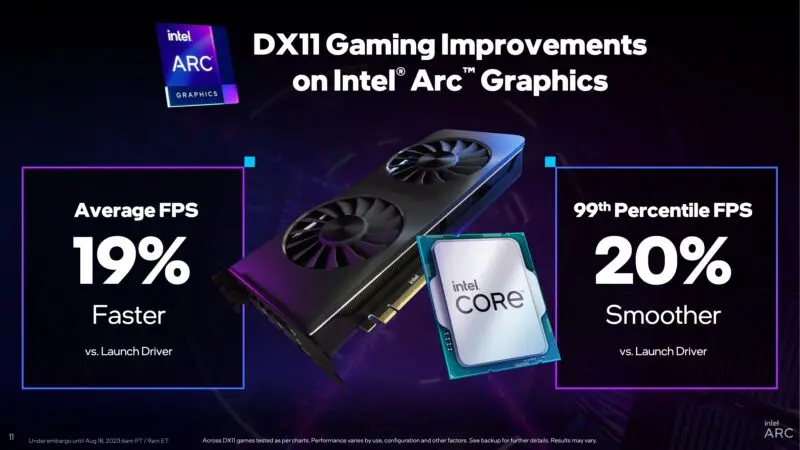reader comments
103
with
When they launched last fall, Intel’s drivers for its Arc dedicated graphics cards were in rough shape. The company’s messaging at the time—and for months beforehand—was something along the lines of, “We’re aware, and we’re working on it.”
I tend to be skeptical of these kinds of "we'll fix it in post” promises; you should buy products based on what they do now and not what the manufacturer promises they will one day be able to do, especially for something like consumer graphics cards where there are plenty of alternatives. But credit where it’s due, Intel has put quite a bit of work into improving its drivers in the year or so since the first Arc cards launched.
Further Reading
Intel A770, A750 review: We are this close to recommending these GPUs
Today the company has rounded up the performance benefits of several improvements made to its DirectX 11 drivers since launch, showing a collection of games that run about 19 percent faster on average than they did last October. Though Arc's performance in modern DirectX 12 and Vulkan games has always been good for the price, older APIs like DirectX 9 and 11 were particular weak points of Arc's when compared to competing cards like the Nvidia GeForce RTX 4060 and 3060 series and the AMD Radeon RX 7600 and 6600 series.
Intel says that it has "rearchitected" its DirectX 11 driver over its last three releases to boost average frame rates and reduce stuttering. An Arc A750 card paired with a Core i5-13400F CPU saw its performance increase by an average of 19 percent with current drivers compared to the launch driver, though some games (Overwatch 2, 33 percent faster) benefit more than others (Destiny 2, only 5 percent faster). Performance gains were also more muted when used with a faster Core i9-13900K, averaging out at around 12 percent (though there likely aren’t too many gaming PCs that pair a $220 GPU with a $570 CPU).
-
Intel's advertised performance gains, comparing an Arc A750 and i5-13400 using the launch driver and a current driver. Intel
-
The same performance gains, normalized. Intel
-
Normalized performance gains on a Core i9. They're a bit less impressive, but still an improvement. Intel
-
Pairing a midrange CPU with a midrange GPU will, in this case, get you a bigger relative speed increase than pairing a midrange GPU with a high-end GPU. Intel
PC games have long lives, and enduringly popular games like Grand Theft Auto V, Overwatch 2, Valorant, and Apex Legends are all keeping DirectX 11 performance relevant for new graphics card buyers. Intel used driver versions 4571 and 4642 for its latest tests; the launch driver version was 3490, and the company released driver version 4644 on Monday.
Advertisement
When "rearchitecting" its DirectX 9 driver, one of the methods Intel used was code translation, using tools like Microsoft’s D3D9On12 to translate DirectX 9 API calls that performed poorly on Arc GPUs to DirectX 12 ones that Arc GPUs are better suited to. Non-Windows devices from the Steam Deck to the Mac are increasingly leaning on these kinds of translation technologies to make games portable between platforms; it only makes sense to lean on them for better performance when it’s possible.
Intel wouldn't tell us directly whether it was using similar technology for any given DirectX 11 game, though the readme that accompanies the latest driver does mention DXVK, a translation layer that can convert DirectX 9, 10, and 11 API calls into Vulkan ones. There’s no mention of D3D11on12, but the company’s statement makes it sound like anything is possible as long as it improves performance.
"Our driver uses a variety of techniques to optimize performance for all APIs," an Intel spokesperson told Ars. "We also use a large variety of 3rd party IP which of course we reference in our release notes. Importantly, our implementation details are fluid and the details change from driver to driver and game to game. At the end of the day the most important facts are our continual performance improvement for gamers."
Further Reading
Intel turns to code translation to run old DirectX9 games on its newest GPUs
It's great to see Intel continue to deliver on its promises, but it's worth noting that DirectX 11 performance on Arc cards remains relatively low even with these gains.
We periodically re-test GPUs with new drivers, but we pay special attention to the Arc cards because of how up-front the company was about how much work its software needed. We last tested with driver version 4369 for our Radeon RX 7600 and GeForce RTX 4060/4060 Ti reviews, so our latest numbers likely don’t reflect some of Intel’s latest optimizations.
But even with a 19 percent performance boost, the Arc A770 and A750 would still fall a bit short of an older GeForce RTX 3060 in DirectX 11 games despite being more than competitive in DirectX 12 games. The driver improvements have made things a lot better than they were, but it’s still a (relative) shortcoming of Intel’s GPUs.
________________________________________________________________________________________________________________________________
Original Article Published at Arstechnica
________________________________________________________________________________________________________________________________

